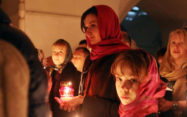
 For 2000 years in the Orthodox Church, the tradition has been for women and girls to veil their heads during worship, whether at church for the liturgy, or at home for family prayer time.
For 2000 years in the Orthodox Church, the tradition has been for women and girls to veil their heads during worship, whether at church for the liturgy, or at home for family prayer time.
What is the Scriptural and Patristic evidence for this tradition, and why is it important?
In this article, we will take a look at headcoverings in the Old Testament, headcoverings in the New Testament, headcoverings according to the early Church, headcoverings in icons, and headcoverings today. At the end of the article there are links to additional resources for learning about Christian headcoverings.
Headcoverings in the Old Testament
Centuries before the birth of Christ, women’s headcoverings were an accepted practice for God’s people. It was not merely an option for those who wished to be holy. Rather, it was a matter-of-fact expectation that all women would cover their heads.

When the Holy Spirit inspired Moses to pen the first five books of Scripture, women’s headcoverings were simply assumed to be the normal practice. In the book of Numbers, when a unique ceremony is performed that requires an uncovered head, Scripture makes a point to say that the woman’s headcovering needs to be removed:
“the priest shall stand the woman before the Lord, uncover the woman’s head, and put the offering for remembering in her hands” (Numbers 5:18)
Of course, such a requirement would make little sense, if women did not normally keep their heads covered.
Even earlier than this, in the book of Genesis, we read about Rebekah, on a journey to meet her future husband, Isaac:
Then Rebekah lifted her eyes, and when she saw Isaac she dismounted from her camel; for she had said to the servant, “Who is this man walking in the field to meet us?” The servant said, “It is my master.” So she took a veil and covered herself. (Genesis 24:64-65)
Her godly discretion is a model for women today. She did not flaunt her physical beauty. Rather, she veiled herself, increasing her allure through an outward display of modesty.
Women’s headcoverings can also be found in the story of Susanna. It is the captivating story of a beautiful, virtuous woman who was falsely accused, and later vindicated by the wisdom of young Daniel. Susanna wore a veil that covered not only her head, but her face as well. Scripture looks disapprovingly upon the removal of her veil:
Now Susanna was exceeding delicate, and beautiful to behold. But those wicked men commanded that her face should be uncovered, (for she was covered,) that so at least they might be satisfied with her beauty. Therefore her friends and all her acquaintance wept. (The Story of Susanna / Daniel 13:31-33)
In this passage of Scripture, virtuous people approve of women’s headcoverings and veils, while ungodly men seek their removal.
Headcoverings in the New Testament
Women’s headcoverings are one of the many points of similarity between Israel and the Church. Godly women had covered their heads for thousands of years prior to the advent of Christ. And when the New Testament Church was born, godly women continued the practice.
In St. Paul’s first epistle to the church in Corinth, he instructs everyone to follow the holy traditions which have been received:
Now, I praise you, brethren, that you remember me in all things and keep the traditions just as I delivered them to you. (1 Corinthians 11:2)
Women’s headcoverings are one of the holy traditions which the Church had received, and St. Paul spends the next several paragraphs discussing them. He says that headcoverings manifest honor, in the context of worship:
Every man praying or prophesying, having his head covered, dishonors his head. (1 Corinthians 11:4)
Every woman who prays or prophesies with her head uncovered dishonors her head. (1 Corinthians 11:5)
The message is pretty clear: It is honorable for a woman to wear headcoverings during worship, but it is dishonorable for men to wear them. This is why men remove their hats for prayer, even to this day.
Not content to make his point only once, St. Paul reiterates himself a few verses later. Women are to cover their heads, and men are not to do so:
A man indeed ought not to cover his head, since he is the image and glory of God; but woman is the glory of man. (1 Corinthians 11:7)
The woman ought to have a symbol of authority on her head, because of the angels. (1 Corinthians 11:10)
The Old Testament reveals that this holy tradition is ancient, but it only begins to hint at the reasons.
Here in the New Testament, we are given some reasons for the practice. According to 1 Corinthians 11, headcoverings manifest a woman’s honor. They also are important “because of the angels”.
Angels are present with us when we pray, and when we worship. While we may not fully understand why headcoverings are important to the angels, it is sufficient for us to know that this reason is given in Scripture. If Scripture says that women’s headcoverings are important to the angels, then it is something we should take seriously.
Headcoverings according to the Early Church Fathers
St. John Chrysostom (d. A.D. 407), in a sermon at the Feast of the Ascension, spoke both of angels and the veiling of women:
“The angels are present here . . . Open the eyes of faith and look upon this sight. For if the very air is filled with angels, how much more so the Church! . . . Hear the Apostle teaching this, when he bids the women to cover their heads with a veil because of the presence of the angels.”
Origen, another prominent teacher in the early Church, said,
“There are angels in the midst of our assembly . . . we have here a twofold Church, one of men, the other of angels . . . And since there are angels present . . . women, when they pray, are ordered to have a covering upon their heads because of those angels. They assist the saints and rejoice in the Church.”
The Apostolic Tradition was written in the second century, and the author is believed to be St. Hippolytus of Rome. This book has instructions for catechumens, including this:
“And let all the women have their heads covered with an opaque cloth . . .”
And St. Cyril of Alexandria, commenting on First Corinthians, wrote:
“The angels find it extremely hard to bear if this law [that women cover their heads] is disregarded.”
Headcoverings in Icons
Icons in the Orthodox Church are a visual guide to the Faith, a sort of “picturebook” of Christianity. Icons teach us about the life, death, and resurrection of Christ, and about the lives of many Christians who have gone before us.

Icons also teach us about headcoverings.
Virtually every icon of an Orthodox woman displays her wearing a headcovering. As far as I know, the only exception is St. Mary of Egypt, and she was a solitary saint who lived alone in the desert, far away from any people.
Among the female saints who participated in society, all of them wore headcoverings, and their headcoverings are shown in icons.
Even Mary the Mother of God–the most blessed woman in the entire universe–is shown in icons, wearing a headcovering.
Can you think of a better role-model for women?
Headcoverings Today
In our church, all women and girls are asked to wear headcoverings, in obedience to God’s command in Scripture, and out of respect for the holy traditions of the Orthodox Church. Just inside the front door of the church, we keep a basket of headcoverings, just in case a woman forgets hers at home and needs to borrow one for the day. Headcoverings are also worn at home, during family prayer time.
While honoring God’s direction is a reward unto itself, there are many other benefits as well. For example:
Headcoverings manifest a woman’s honor. As St. Paul points out in Scripture, a woman brings honor to herself by covering her head during prayer.
Headcoverings encourage humility. Godly women come to church to focus on worship, not to draw attention to themselves. A girl may be tempted to show off an attractive hairdo. When a woman wears a headcovering, this temptation is removed. She can focus on prayer, instead of on hair.
Headcoverings save time. In today’s culture, it can be tempting to spend a lot of time and energy on hairstyles. But headcoverings are quick and easy. It takes a lot less time to put on a headcovering, than it does to prepare a hairdo for display.
Headcoverings help us show love and consideration for our brothers. Godly men come to church to focus on worship. But the flowing locks of beautiful woman can be distracting. By veiling her hair, a woman can display her modesty, and remove an unnecessary distraction.

A mainstream theological journal recently published an article about women’s headcoverings. Soon after, the author of the article became a member of the Orthodox Church. In the article, she beautifully illustrates the iconic purpose of headcoverings:
“My wearing a head covering is not only a symbol or sign that I am in agreement with His order, but that I visibly, willingly submit to it. With submission comes blessing.” (Christa Conrad)
In an issue of The Handmaiden, a lady named Elizabet gives her testimony about wearing headcoverings:
For twelve years I have worn a scarf [headcovering] at all times. I now perceive that it has been—and continues to be—essential for the pilgrim journey and salvation of my soul. The bottom line for me—and a growing number of my sisters—remains obedience. And with it comes a sense of being in our rightful place in God’s ordered universe, rejoicing with the angels. Now I gratefully say, “I am!” in the presence of the great I AM—at prayer and in church, surrounded by the angelic host, worshipping our Lord and King. To God, Father, Son, and Holy Spirit, be the glory, now and ever and unto ages of ages. Amen!
By Fr J. Gleason



